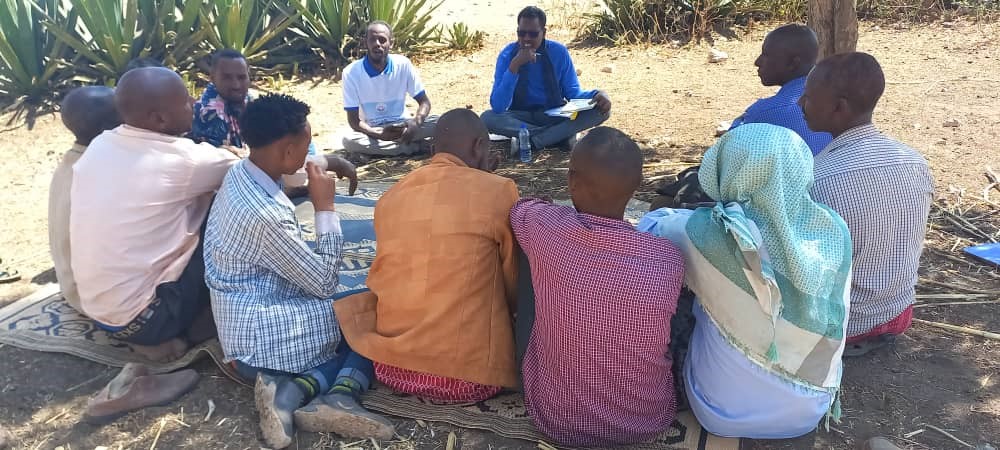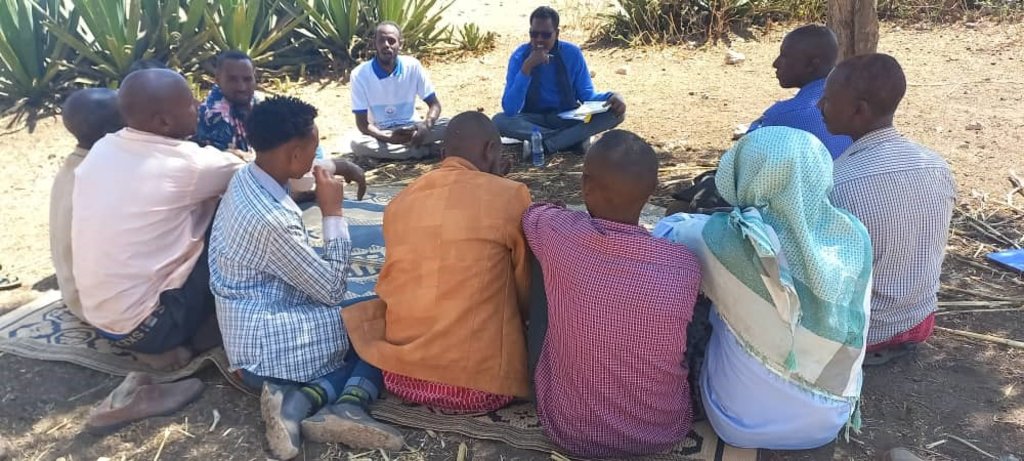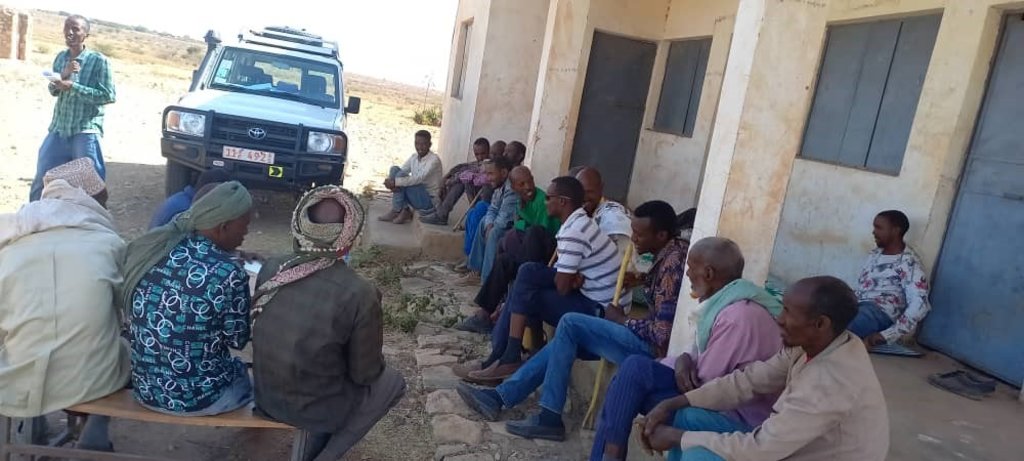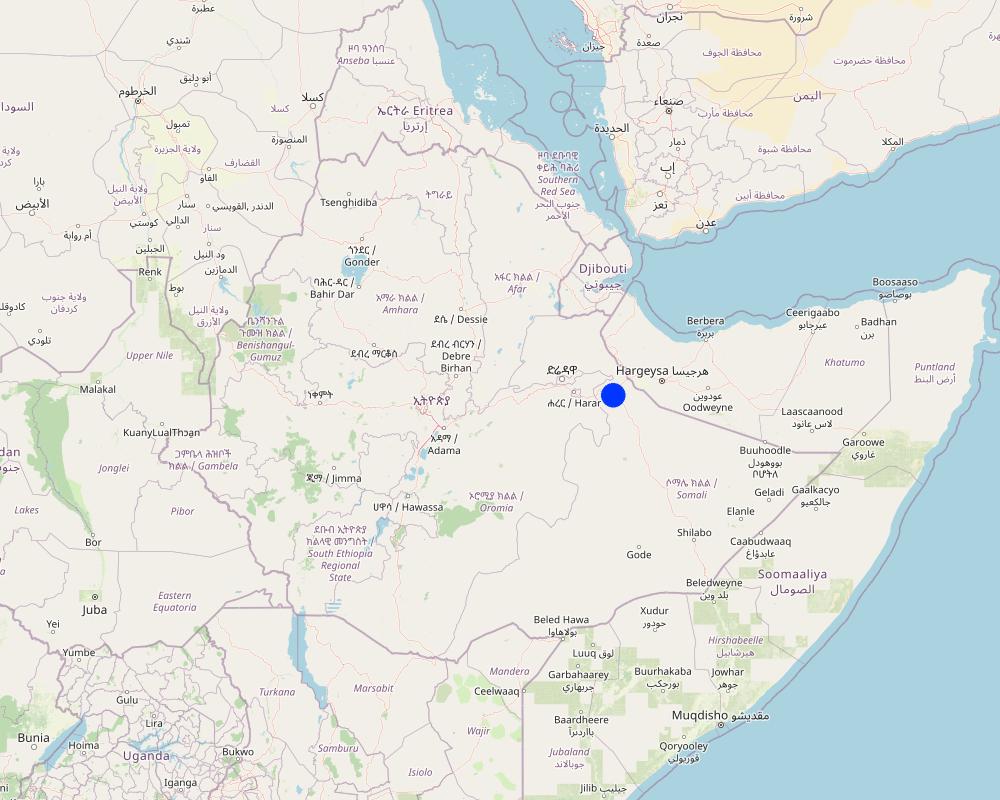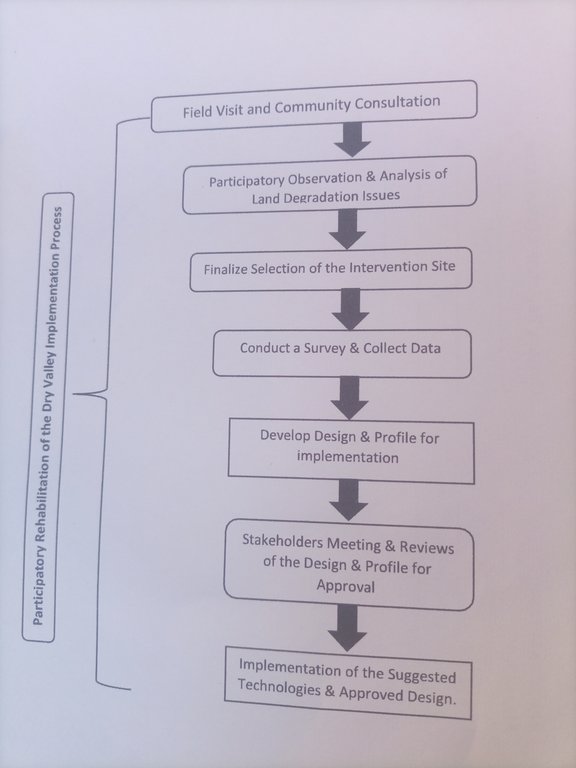Participatory Rehabilitation of Dry Valleys [เอธิโอเปีย]
- ผู้สร้างสรรค์:
- การอัพเดท:
- ผู้รวบรวม: GERBA LETA
- ผู้เรียบเรียง: Torben Helbig, Noel Templer, Tabitha Nekesa, Ahmadou Gaye, Siagbé Golli
- ผู้ตรวจสอบ: William Critchley, Rima Mekdaschi Studer, Sally Bunning
Kaqayb Galka Dadwayne
approaches_6718 - เอธิโอเปีย
ดูส่วนย่อย
ขยายทั้งหมด ย่อทั้งหมด1. ข้อมูลทั่วไป
1.2 รายละเอียดที่ติดต่อได้ของผู้รวบรวมและองค์กรที่เกี่ยวข้องในการประเมินและการจัดเตรียมทำเอกสารของแนวทาง
วิทยากรหลัก
ผู้เชี่ยวชาญ SLM:
Omer Ahmed
+251910061493
ahmdomr1954@gmail.com
Natural Resource Department of Somali Regional State Bureau of Agriculture
Somali Regional State, JigJiga
เอธิโอเปีย
ชื่อของโครงการซึ่งอำนวยความสะดวกในการทำเอกสารหรือการประเมินแนวทาง (ถ้าเกี่ยวข้อง)
Soil protection and rehabilitation for food security (ProSo(i)l)ชื่อของโครงการซึ่งอำนวยความสะดวกในการทำเอกสารหรือการประเมินแนวทาง (ถ้าเกี่ยวข้อง)
CIAT International Center for Tropical Agriculture (CIAT International Center for Tropical Agriculture) - เคนยา1.3 เงื่อนไขที่เกี่ยวข้องกับการใช้ข้อมูลที่ได้บันทึกไว้ผ่านทาง WOCAT
วันที่เก็บรวบรวมข้อมูล (ภาคสนาม):
22/03/2023
ผู้รวบรวมและวิทยากรหลักยอมรับเงื่อนไขเกี่ยวกับการใช้ข้อมูลที่ถูกบันทึกผ่านทาง WOCAT:
ใช่
1.4 การอ้างอิงถึงแบบสอบถามเรื่องเทคโนโลยี SLM
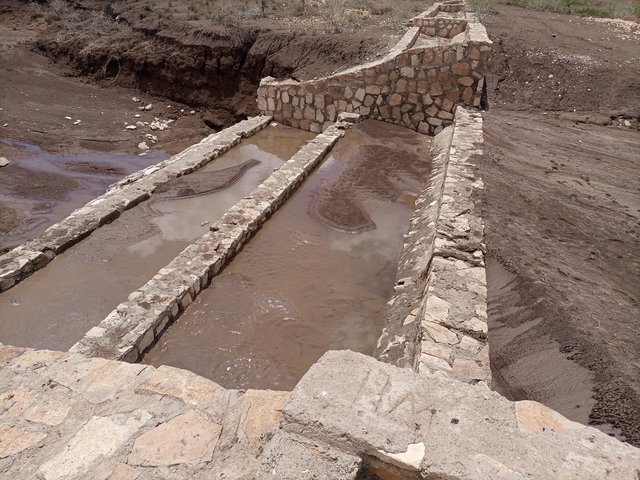
Double Basin Masonry Check Dam [เอธิโอเปีย]
A double basin masonry check dam is a physical structure that helps to stop gully formation or further development of gullies in dry valleys. It rehabilitates small to a medium-sized deep gullies that are eating into the heart of adjacent land.
- ผู้รวบรวม: GERBA LETA
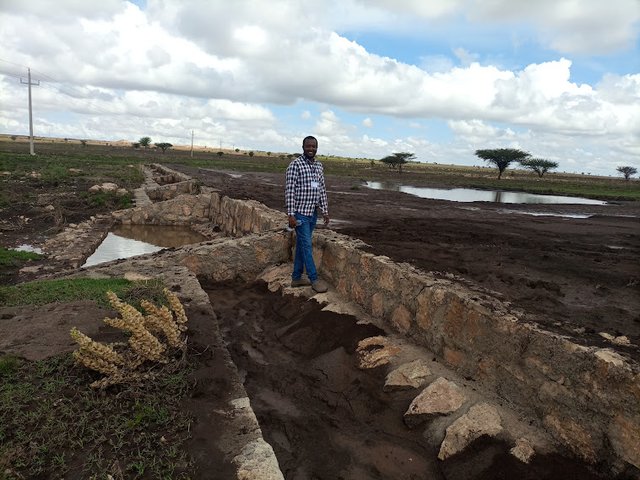
Water Spreading Weirs [เอธิโอเปีย]
Water Spreading Weirs are designed to protect the degradation of agricultural fields and rangelands. They contribute to soil and water conservation and enhance the productive use of dry valleys for food crops and livestock fodder production via the harvest and spread of runoff water and fertile soils.
- ผู้รวบรวม: GERBA LETA
2. คำอธิบายของแนวทาง SLM
2.1 การอธิบายแบบสั้น ๆ ของแนวทาง
Participatory rehabilitation and productive use of dry valleys is an approach employed to rehabilitate degraded and degradable land. It is operationalised through the Lowland Soil Rehabilitation Project with local development partners from kebele, district, regional agricultural bureaus, and other relevant stakeholders.
2.2 การอธิบายอย่างละเอียดของแนวทาง
การอธิบายอย่างละเอียดของแนวทาง:
Participatory rehabilitation of degraded and degradable dry valleys engages the community at the grassroots through consultation. It is operationalised through the Lowland Soil Rehabilitation Project with local development partners from kebele, district, regional agricultural bureaus, and other relevant stakeholders.
Technical experts from the district and region are involved in reconnaissance, observation and joint selection of the intervention sites. The team conduct a survey, then profile and design the technologies required, along with the project engineer. The approach optimises the participation of the community and agricultural actors, allowing the development of a sense of ownership and accountability through training and awareness-creation exercises. In turn this encourages them to take care of and maintain the structures.
This approach combines top-down and bottom-up methods. At the grassroots, the local agropastoral communities are mobilized by local extension agents and made aware about the SLM intervention that the project and partners strive to put in place – including the physical structures in the farmers' fields and communal lands. The procedures include a site visit, a survey/ observation, and the identification of the intervention site based on the specific topographic features and drainage system of the catchment. Then, detailed field data is collected and a profile analysis is made to develop the design and get approval after stakeholders’ consultation and review of the details of the implementation design. The approach is complemented by satellite imagery and ground truthing. Following this, the next stage is identification of masonry experts, provision of training, and supply of construction materials and tools. Building the masonry works involves both skilled and unskilled labour.
The woreda NRM expert (focal person) facilitate the process at the grassroots through the development agents. The community gives their consent and support to the objectives of the project implementation. Therefore, they are involved in local decision-making and overseeing the technology that is being put in place.
The agropastoral community is the end user and benefits from the positive consequences of the intervention which is a result of better management of soil and water for productive uses of the dry valley. However, because of a lack of awareness, and the agropastoralists conventional livelihoods practice traveling with their livestock, there is a lack of participation in the day-to-day implementation activities. That limits their active contribution in implementation. Of course, local elders value the consultative experience which confirms a sense of self-worth and acknowledges their role in ownership of the land and as the ultimate decision-maker for development intervention operating in their areas.
2.3 รูปภาพของแนวทาง
ข้อสังเกตทั่วไปเกี่ยวกับรูปภาพ:
Photos (undated) obtained from project staff of community engagement taking place at the beginning of the project implementation.
2.4 วีดีโอของแนวทาง
ความคิดเห็น อธิบายสั้นๆ:
Video of the approach was not documented.
2.5 ประเทศ ภูมิภาค หรือสถานที่ตั้งที่ได้นำแนวทางไปใช้
ประเทศ:
เอธิโอเปีย
ภูมิภาค/รัฐ/จังหวัด: :
Somali
ข้อมูลเฉพาะเพิ่มเติมของสถานที่ตั้ง:
Amadle kebele, South Jijiga district
Map
×2.6 วันที่เริ่มต้นและสิ้นสุดของแนวทาง
ระบุปีที่เริ่ม:
2021
ความคิดเห็น:
The project termination date is not indicated.
2.7 ประเภทของแนวทาง
- ใช้โครงงานหรือแผนงานเป็นฐาน
2.8 เป้าหมายหรือวัตถุประสงค์หลักของแนวทาง
To engage the community and other stakeholders in making participatory decisions on the rehabilitation of the dry valley.
2.9 เงื่อนไขที่เอื้ออำนวยหรือเป็นอุปสรรคต่อการนำเทคโนโลยีภายใต้แนวทางนี้ไปปฏิบัติใช้
การมีไว้ให้หรือการเข้าถึงแหล่งการเงินและบริการ
- เอื้ออำนวย
Access to finance promotes intensive awareness creation and participation of the community to implement the technology at a larger scale. Also, it allows supporting the maintenance and other follow on actions that ensure sustainability.
การจัดตั้งระดับองค์กร
- เอื้ออำนวย
Setting up the local institution such as an agropastoralist group enables the effective implementation of dry valley rehabilitation technologies/practices.
การร่วมมือหรือการทำงานประสานกันของผู้ลงมือปฏิบัติ
- เอื้ออำนวย
Coordination of actors enables the identification of useful actors and cross-fertilize experiential knowledge for documentation and further uses. Also, it enables acknowledgment of the contribution of different actors.
ความรู้เกี่ยวกับ SLM การเข้าถึงการสนับสนุนด้านเทคนิค
- เอื้ออำนวย
Having SLM knowledge enables efficient and effective implementation of dry valley rehabilitation technologies.
ปริมาณงานที่ทำได้ กำลังคนที่มีให้
- เอื้ออำนวย
Labour in the agropastoralist area is the limiting factor for the effective implementation of SLM practices. Therefore, the availability of labor or manpower is pivotal for the proper implementation of the SLM.
3. การมีส่วนร่วมและบทบาทของผู้มีส่วนได้ส่วนเสียที่เกี่ยวข้อง
3.1 ผู้มีส่วนได้ส่วนเสียที่เกี่ยวข้องในแนวทางนี้และบทบาท
- ผู้ใช้ที่ดินระดับท้องถิ่นหรือชุมชนระดับท้องถิ่น
Agropastoralist.
Participatory planning and decision making, sources casual laborer and oversee the technologies/practices.
- ผู้เชี่ยวชาญ SLM หรือที่ปรึกษาการเกษตร
Natural Resource Management experts.
Facilitate stakeholders' participation, provide technical support, and backstopping services, and monitor the development during and after the implementation of the technologies.
- ภาคเอกชน
Contractor to perform the engineering works.
Building/constructing the physical structures.
- GIZ project
GIZ (bilateral cooperation) projects.
Provide financial and technical support to the government partner organizations to promote the proper implementation of the rehabilitation of dry valley.
3.2 การเกี่ยวข้องของผู้ใช้ที่ดินระดับท้องถิ่นหรือชุมชนระดับท้องถิ่นในช่วงต่างๆของแนวทาง
| ความเกี่ยวข้องของผู้ใช้ที่ดินระดับท้องถิ่นหรือชุมชนระดับท้องถิ่น | ระบุผู้ที่มีส่วนเกี่ยวข้องและอธิบายกิจกรรม | |
|---|---|---|
| การริเริ่มหรือการจูงใจ | ปฏิสัมพันธ์ | Agropastoralists involve in allowing peers to understand SLM-related intervention. |
| การวางแผน | ปฏิสัมพันธ์ | Land users involve in participatory planning and decision-making exercise. |
| การดำเนินการ | จ่ายเงินหรือสนับสนุนจากภายนอก | Skilled and unskilled laborers are sources from neighboring urban areas and the intervention kebeles. |
| การติดตามตรวจสอบหรือการประเมินผล | จ่ายเงินหรือสนับสนุนจากภายนอก | SLM experts and extension agents support in monitoring and evaluation of the intervention activities. |
3.3 แผนผังแสดงขั้นตอนการทำงาน (ถ้ามี)
คำอธิบาย:
The sketch describe the process of implementing Participatory Rehabilitation of Dry Valleys.
ผู้เขียน:
Gerba Leta
3.4 การตัดสินใจเลือกใช้เทคโนโลยี SLM
ระบุผู้ที่ทำการตัดสินใจเลือกเทคโนโลยีมากกว่าหนึ่งวิธีไปปฏิบัติใช้:
- ผู้เชี่ยวชาญ SLM เป็นผู้ตัดสินใจหลัก ที่ติดตามให้คำปรึกษากับผู้ใช้ที่ดิน
การอธิบาย:
The communities are consulted, however, selection decision is made by the SLM experts of the partner organizations in consultation with the project SLM specialists.
ระบุว่าการตัดสินใจตั้งอยู่บนพื้นฐานของ:
- การประเมินความรู้ SLM ที่ได้ทำการบันทึกไว้เป็นอย่างดี (การใช้ข้อมูลในการตัดสินใจ)
4. การสนับสนุนด้านเทคนิค การสร้างขีดความสามารถ และการจัดการด้านความรู้
4.1 การสร้างขีดความสามารถ / การอบรม
ได้มีการจัดอบรมให้แก่ผู้ใช้ที่ดินหรือผู้มีส่วนได้ส่วนเสียคนอื่น ๆ หรือไม่:
ใช่
ให้ระบุว่าใครเป็นผู้ได้รับการอบรม:
- เจ้าหน้าที่ภาคสนาม / ที่ปรึกษา
รูปแบบการอบรม:
- กำลังดำเนินการ
- จัดการประชุมสู่สาธารณชน
รูปแบบการอบรม:
- Masonry workers
หัวข้อที่พูด:
Dry Land Rehabilitation and Produce Use of the rehabilitated land. Basically, the training is on the SLM practices which are suitable for agropastoralist areas with special emphasis on the physical structure.
ความคิดเห็น:
SLM experts from partner organizations and masonry workers were trained to assist in the implementation of SLM practices for dry land rehabilitation.
4.2 การบริการให้คำแนะนำ
ผู้ใช้ที่ดินมีการเข้าถึงการรับบริการให้คำปรึกษาหรือไม่:
ใช่
ระบุว่ามีบริการให้คำปรึกษาหรือไม่:
- ไปเยี่ยมชมสถานที่
การอธิบาย/แสดงความคิดเห็น:
Advisory services related to SLM are infrequently given. As the agropastoralists are mobile looking for feed and water, particularly during the dry period, advisory services have not been provided on regular basis.
4.3 การเสริมความแข็งแกร่งให้กับสถาบัน (การพัฒนาองค์กร)
สถาบันได้รับการจัดตั้งขึ้นมาหรือเสริมความแข็งแกร่งโดยแนวทางนี้หรือไม่:
- ใช่ เล็กน้อย
ระบุระดับของสถาบันที่ได้รับการเสริมความแข็งแกร่งหรือจัดตั้งขึ้นมา:
- ท้องถิ่น
อธิบายถึงสถาบัน บทบาทและความรับผิดชอบ สมาชิก เป็นต้น:
Stakeholders from government and bilateral organization (project) do make ad hoc meeting during planning and evaluation, this brings actors together but need to establish a sustainable institution that stands on its own and can be working beyond the project's lifetime. Particularly, a land users (agropastoralist) group is essential to oversee the technology placed on their land so that sustainability of the intervention can be ensured.
ระบุประเภทของการให้ความช่วยเหลือสนับสนุน:
- ด้านการเงิน
- การสร้างขีดความสามารถ / การอบรม
- อุปกรณ์
ให้รายละเอียดเพิ่มเติม :
The equipment refers to the technical tools that can be used by the partner experts - but not farm tools. The latter is expected during which the agropastoralist resumes the productive use of the rehabilitated land which is currently in the initial years of implementation and not yet associated with the productive uses of it.
4.4 การติดตามตรวจสอบและประเมินผล
การติดตามตรวจสอบและประเมินผลเป็นส่วนหนึ่งของแนวทางหรือไม่:
ใช่
ความคิดเห็น:
The monitoring and evaluation are part of the project implementation that enables the implementers to track the development and engage the end users to enable them to sense the benefits. The land users started to benefit from the structure such as fetching drinking water both for human and their livestock, though, it is an indirect benefit from the intervention.
ถ้าตอบว่าใช่ แสดงว่าการจัดเตรียมเอกสารนี้มุ่งหวังที่จะเอาไปใช้สำหรับการติดตามตรวจสอบและประเมินผลใช่หรือไม่:
ใช่
4.5 การวิจัย
การวิจัยเป็นส่วนหนึ่งของแนวทางหรือไม่:
ไม่ใช่
5. การสนับสนุนด้านการเงินและวัสดุอุปกรณ์
5.1 ระบุงบประมาณประจำปีสำหรับแนวทาง SLM นี้
ถ้าหากว่างบประมาณประจำปีไม่เป็นที่ทราบแน่นอน ให้ระบุช่วงลงไป:
- 2,000-10,000
แสดงความคิดเห็น (แหล่งของการระดมทุน ผู้บริจาคคนสำคัญ):
No specific data on budget allocation for SLM at the district level. However, Local Subsidy Contract (LSC) was used to assist the woreda implement and follow-up the development of the intervention.
5.2 การสนับสนุนด้านการเงิน / วัสดุอุปกรณ์ให้แก่ผู้ใช้ที่ดิน
ผู้ใช้ที่ดินได้รับการสนับสนุนด้านการเงิน / วัสดุอุปกรณ์ไปปฏิบัติใช้เทคโนโลยีหรือไม่:
ไม่ใช่
5.3 เงินสนับสนุนสำหรับปัจจัยนำเข้า (รวมถึงแรงงาน)
ความคิดเห็น:
There is no subsidy system supplied to the land users. Labor contribution is on a pay basis in cash. As the area is characterized by food insecurity and drought-prone by virtue, free labor is not expected. Basically, skilled and unskilled labor imported from the nearby town. Thus, it is impossible to assign this role to the land users.
5.4 เครดิต
มีการจัดหาเครดิตมาให้ภายใต้แนวทาง SLM หรือไม่:
ไม่ใช่
5.5 แรงจูงใจหรือเครื่องมืออื่น ๆ
แรงจูงใจหรือเครื่องมืออื่น ๆ ได้ถูกนำไปใช้ส่งเสริมการใช้เทคโนโลยี SLM หรือไม่:
ไม่ใช่
6. การวิเคราะห์ผลกระทบและการสรุป
6.1 ผลกระทบของแนวทาง
ทำให้ผู้ใช้ที่ดินระดับท้องถิ่นมีอำนาจขึ้น ปรับปรุงการเข้าร่วมของผู้มีส่วนได้ส่วนเสียให้ดีขึ้นหรือไม่:
- ไม่ใช่
- ใช่ เล็กน้อย
- ใช่ ปานกลาง
- ใช่ อย่างมาก
Local land users consulted and informed regarding the benefits of SLM for the degraded and potentially degradable lands to ensure rehabilitation and its productive use. This may give motivation and a sense of self-worth as land owner.
ช่วยในการตัดสินใจโดยดูจากหลักฐาน ได้หรือไม่:
- ไม่ใช่
- ใช่ เล็กน้อย
- ใช่ ปานกลาง
- ใช่ อย่างมาก
Beyond the approach, the land users can learn from the actual function of the technologies.
ช่วยให้ผู้ใช้ที่ดินนำเอาเทคโนโลยี SLMไปใช้และบำรุงรักษาสภาพไว้ได้หรือไม่:
- ไม่ใช่
- ใช่ เล็กน้อย
- ใช่ ปานกลาง
- ใช่ อย่างมาก
Consultation with the land users motivates them to build trust in the intervention.
ปรับปรุงความร่วมมือกันและการดำเนิน งานของ SLM ได้อย่างมีประสิทธิผลหรือไม่:
- ไม่ใช่
- ใช่ เล็กน้อย
- ใช่ ปานกลาง
- ใช่ อย่างมาก
In the long run, it can assist land users mobilize casual laborers.
ระดมกำลังหรือปรับปรุงการเข้าถึงแหล่ง เงินทุนสำหรับการดำเนินการ SLM หรือไม่:
- ไม่ใช่
- ใช่ เล็กน้อย
- ใช่ ปานกลาง
- ใช่ อย่างมาก
ปรับปรุงความรู้และความสามารถของผู้ใช้ที่ดินในการดำเนินการ SLM หรือไม่:
- ไม่ใช่
- ใช่ เล็กน้อย
- ใช่ ปานกลาง
- ใช่ อย่างมาก
The approach creates an opportunity for land users to engage in the initial implementation process through which their awareness is raised.
ปรับปรุงความรู้และความสามารถของผู้มีส่วนได้ส่วนเสียคนอื่น ๆ ให้ดีขึ้นหรือไม่:
- ไม่ใช่
- ใช่ เล็กน้อย
- ใช่ ปานกลาง
- ใช่ อย่างมาก
Through stakeholders meeting and training opportunities created by the project.
ทำให้ผู้ใช้ที่ดินระดับท้องถิ่นมีอำนาจขึ้น ปรับปรุงการเข้าร่วมของผู้มีส่วนได้ส่วนเสียให้ดีขึ้นหรือไม่:
- ไม่ใช่
- ใช่ เล็กน้อย
- ใช่ ปานกลาง
- ใช่ อย่างมาก
It builds collaboration between stakeholders.
ช่วยบรรเทาความขัดแย้งหรือไม่:
- ไม่ใช่
- ใช่ เล็กน้อย
- ใช่ ปานกลาง
- ใช่ อย่างมาก
ทำให้กลุ่มด้อยโอกาสมีอำนาจทางสังคมและเศรษฐกิจหรือไม่:
- ไม่ใช่
- ใช่ เล็กน้อย
- ใช่ ปานกลาง
- ใช่ อย่างมาก
Involve them in the awareness creation training.
ปรับปรุงความทัดเทียมกันด้านเพศและให้อำนาจแก่ผู้หญิงและเด็กผู้หญิงหรือไม่:
- ไม่ใช่
- ใช่ เล็กน้อย
- ใช่ ปานกลาง
- ใช่ อย่างมาก
Women are involved in the community meeting and/or consultation. Also benefited from the technology as it creates the opportunity to fetch drinking still water closer to their residence.
ส่งเสริมให้เยาวชนหรือบุตรหลานของผู้ใช้ที่ดินให้เข้าร่วมใน SLM:
- ไม่ใช่
- ใช่ เล็กน้อย
- ใช่ ปานกลาง
- ใช่ อย่างมาก
It provides knowledge to the young generation through exposure to evidence based intervention.
ปรับปรุงประเด็นของการถือครองที่ดินหรือสิทธิในการใช้ ซึ่งขัดขวางการนำเทคโนโลยีไปใช้ให้ดีขึ้น:
- ไม่ใช่
- ใช่ เล็กน้อย
- ใช่ ปานกลาง
- ใช่ อย่างมาก
นำไปสู่ความมั่นคงด้านอาหารหรือปรับปรุงโภชนาการให้ดีขึ้น:
- ไม่ใช่
- ใช่ เล็กน้อย
- ใช่ ปานกลาง
- ใช่ อย่างมาก
The technology implemented using the participatory approach believed to rehabilitate degraded lands and enhances productive use of the rehabilitated lands for growing various crops, and supply feeds to the livestock.
ปรับปรุงการเข้าถึงตลาดหรือไม่:
- ไม่ใช่
- ใช่ เล็กน้อย
- ใช่ ปานกลาง
- ใช่ อย่างมาก
นำไปสู่การเข้าถึงเรื่องน้ำและสุขาภิบาลได้ดีขึ้นหรือไม่:
- ไม่ใช่
- ใช่ เล็กน้อย
- ใช่ ปานกลาง
- ใช่ อย่างมาก
The technology implemented using this approach creates land users temporal access to still as well as groundwater regardless.
นำไปสู่การใช้ที่ดินอย่างยั่งยืนหรือแหล่งพลังงานหรือไม่:
- ไม่ใช่
- ใช่ เล็กน้อย
- ใช่ ปานกลาง
- ใช่ อย่างมาก
ปรับปรุงความสามารถของผู้ใช้ที่ดินในการปรับตัวให้เข้ากับการเปลี่ยนแปลงของสภาพภูมิอากาศหรือสภาพที่รุนแรงและภัยพิบัติหรือไม่:
- ไม่ใช่
- ใช่ เล็กน้อย
- ใช่ ปานกลาง
- ใช่ อย่างมาก
In the future, when the productive use of dry valley is effected, post the rehabilitation efforts, land users certainly develop an adaptation to climate change and associated disasters through participatory approach.
นำไปสู่โอกาสในการจ้างงาน รายได้หรือไม่:
- ไม่ใช่
- ใช่ เล็กน้อย
- ใช่ ปานกลาง
- ใช่ อย่างมาก
It improves generation of income from the production of food and feed crops.
6.2 แรงจูงใจหลักของผู้ใช้ที่ดินเพื่อที่จะนำ SLM ไปปฏิบัติใช้
- การผลิตที่เพิ่มขึ้น
Food crops and livestock feed production are increased as the technology reduces the intensity and effects of erosion and conserves soil and water.
- กำไร (ความสามารถ) อัตราส่วนค่าใช้จ่ายต่อผลประโยชน์ที่เพิ่มขึ้น
Over time, the technology/approach improves the productive use of rehabilitated land for crop and livestock production that increases overall benefits.
- การเสื่อมของที่ดินลดลง
As the structure stops heavy movement of the soil with runoff, it absolutely reduces the rate or speed of erosion and land degradation.
- ความเสี่ยงของภัยพิบัติลดลง
The water harvested and spread on the farmland reduces the risks of crop failure and can be used for spate irrigation. Furthermore, the structure reduces the speed of runoff and retain the top soil moving away.
- ความรู้และทักษะ SLM ที่เพิ่มพูนขึ้น
The exposure to training and collective action and lesson learnt from the outcome of the implementation enhance knowledge and skills of the land users and experts.
6.3 ความยั่งยืนของกิจกรรมของแนวทาง
ผู้ใช้ที่ดินสามารถทำให้สิ่งต่างๆ ที่ได้ปฏิบัติใช้โดยแนวทางนี้ยั่งยืนได้หรือไม่ (โดยไม่มีการสนับสนุนจากภายนอก):
- ไม่แน่ใจ
ถ้าตอบว่าไม่หรือไม่แน่ใจ ให้ระบุและแสดงความคิดเห็น :
As maintenance of the structure such as in cases of check dam is resource demanding, it is less likely for the land users to maintain/repair on their own. Rather early combining the physical structure by biological barriers or perennial forage or tree planation may ensure sustainability of the technology/land use. Furthermore, it demands time and labor from the agro-pastoralists.
6.4 จุดแข็งและข้อได้เปรียบของแนวทาง
| จุดแข็ง / ข้อได้เปรียบของแนวทางในทัศนคติของผู้ใช้ที่ดิน |
|---|
| Creates stakeholders awareness on SLM, and productive use of rehabilitated dry valley. |
| Improves coordination between agricultural actors in line offices, and other stakeholders collective action. |
| Enhances participatory decision making on the development and use of the rehabilitated lands. |
| จุดแข็ง / ข้อได้เปรียบของแนวทางในทัศนคติของผู้รวบรวมหรือวิทยากรหลัก |
|---|
| It creates evidence based lesson learning to replicate similar practices across the region. |
| It improves SLM implementation capacity of the development partners (agricultural offices) and the land users at local level. |
| It encourages the government respective department to allocate matching fund for SLM operationalized by development partners. |
6.5 จุดอ่อน / ข้อเสียเปรียบของแนวทางและวิธีในการแก้ไข
| จุดอ่อน / ข้อเสียเปรียบในทัศนคติของผู้ใช้ที่ดิน | สามารถแก้ไขปัญหาได้อย่างไร |
|---|---|
| Time and energy/labor demanding to integrate efforts of experts from different organizations. | Nurture proper joint planning for collective action. |
| Shortage of financial and material resources to put the structure in place. | Find and generate sources of resources and promote efficient use of the available budget. |
| Improper participation of stakeholders (dropout of experts) | Enforce participation through adopting binding by-laws to all. |
| จุดอ่อน / ข้อเสียเปรียบในทัศนคติของผู้รวบรวมหรือวิทยากรหลัก | สามารถแก้ไขปัญหาได้อย่างไร |
|---|---|
| Recurrent droughts displace the land users while looking for water and feed to their animals. | Ensure representation to the community, and assess enabling environment that reduce temporal displacement of the land users. |
| Relatively low participation of the land users in the conception and implementation of the approach as well as the technology intended to rehabilitate the dry valley. | Promote land users participation through intensive capacity building and awareness creation by gender and various categories of the community. |
| Lack of forming agro-pastoralist group who are believed to share knowledge, skills and labor for collective oversee and maintenance of the technology when damage is encountered. | Promote the development of a local institution that allows not only for the use of the land but also to oversee the gaps, report the issues, and involve in participatory fixing activities. |
7. การอ้างอิงและการเชื่อมต่อ
7.1 วิธีการหรือแหล่งข้อมูล
- ไปเยี่ยมชมภาคสนาม การสำรวจพื้นที่ภาคสนาม
Three individuals
- การสัมภาษณ์ผู้เชี่ยวชาญด้าน SLM หรือผู้ชำนาญ
Four
7.2 การอ้างอิงถึงสิ่งตีพิมพ์
ชื่อเรื่อง ผู้เขียน ปี ISBN:
Problems and landscape approach for ecological rehabilitation in the dry valleys of Southwest China. Dong, Y. & Liu, S. (Undated)
ช่องทางในการสืบค้น และราคา:
https://www.researchgate.net/profile/Shiliang-Liu-5/publication/221354340_Problems_and_Landscape_Approach_for_Ecological_Rehabilitation_in_the_Dry_Valleys_of_Southwest_China/links/574129be08ae9ace84160bec/
7.3 เชื่อมโยงกับข้อมูลที่มีอยู่บนออนไลน์
ชื่อเรื่องหรือคำอธิบาย:
Supporting local planning and the importance of mapping
URL:
https://dream.vandermeijde.net/wp-content/uploads/2022/11/220620_planningandmapping_Roden.pdf
ลิงก์และโมดูล
ขยายทั้งหมด ย่อทั้งหมดลิงก์

Double Basin Masonry Check Dam [เอธิโอเปีย]
A double basin masonry check dam is a physical structure that helps to stop gully formation or further development of gullies in dry valleys. It rehabilitates small to a medium-sized deep gullies that are eating into the heart of adjacent land.
- ผู้รวบรวม: GERBA LETA

Water Spreading Weirs [เอธิโอเปีย]
Water Spreading Weirs are designed to protect the degradation of agricultural fields and rangelands. They contribute to soil and water conservation and enhance the productive use of dry valleys for food crops and livestock fodder production via the harvest and spread of runoff water and fertile soils.
- ผู้รวบรวม: GERBA LETA
โมดูล
ไม่มีโมดูล


